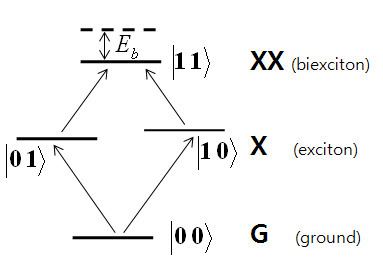 | ||
In condensed matter physics, biexcitons are created from two free excitons.
Contents
Formation of biexcitons
In quantum information and computation, it is essential to construct coherent combinations of quantum states. The basic quantum operations can be performed on a sequence of pairs of physically distinguishable quantum bits and, therefore, can be illustrated by a simple four-level system.
In an optically driven system where the
Observation of biexcitons
Three possibilities of observing biexcitons exist:
(a) excitation from the one-exciton band to the biexciton band (pump-probe experiments);
(b) two-photon absorption of light from the ground state to the biexciton state;
(c) luminescence from a biexciton state made up from two free excitons in a dense exciton system.
Binding energy of biexcitons
The biexciton is a quasi-particle formed from two excitons, and its energy is expressed as
where
When a biexciton is annihilated, it disintegrates into a free exciton and a photon. The energy of the photon is smaller than that of the biexciton by the biexciton binding energy, so the biexciton luminescence peak appears on the low-energy side of the exciton peak.
The biexciton binding energy in semiconductor quantum dots has been the subject of extensive theoretical study. Because a biexciton is a composite of two electrons and two holes, we must solve a four-body problem under spatially restricted conditions. The biexciton binding energies for CuCl quantum dots, as measured by the site selective luminescence method, increased with decreasing quantum dot size. The data were well fitted by the function
where
A simple model for describing binding energy of biexcitons
In the effective-mass approximation, the Hamiltonian of the system consisting of two electrons (1, 2) and two holes (a, b) is given by
where
where
where
Denoting
where
In the units of the exciton Rydberg and Bohr radius, the Hamiltonian can be written in dimensionless form
where
To solve the problem of the bound states of the biexciton complex, it is required to find the wave functions
If the eigenvalue
where
Numerical calculations of the binding energies of biexcitons
The diffusion Monte Carlo (DMC) method provides a straightforward means of calculating the binding energies of biexcitons within the effective mass approximation. For a biexciton composed of four distinguishable particles (e.g., a spin-up electron, a spin-down electron, a spin-up hole and a spin-down hole), the ground-state wave function is nodeless and hence the DMC method is exact. DMC calculations have been used to calculate the binding energies of biexcitons in which the charge carriers interact via the Coulomb interacion in two and three dimensions, indirect biexcitons in coupled quantum wells, and biexcitons in monolayer transition metal dichalcogenide semiconductors.
Binding energy in nanotubes
Biexcitons with bound complexes formed by two excitons are predicted to be surprisingly stable for carbon nanotube in a wide diameter range. Thus, a biexciton binding energy exceeding the inhomogeneous exciton line width is predicted for a wide range of nanotubes.
The biexciton binding energy in carbon nanotube is quite accurately approximated by an inverse dependence on
The actual biexciton binding energy is inversely proportional to the physical nanotube radius. Experimental evidence of biexcitons has yet to be found.
Binding energy in CuCl QDs
The binding energy of biexcitons increase with the decrease in their size and its size dependence and bulk value are well represented by the expression
where
